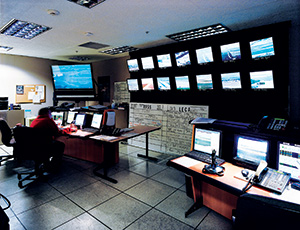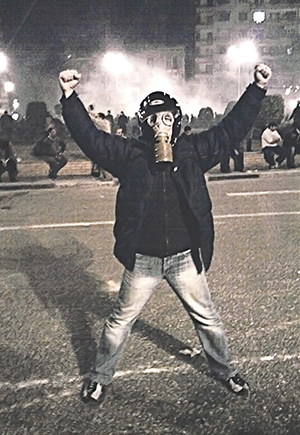

The artist collective Electronic Disturbance Theater 2.0 can’t seem to do anything without causing problems.
Nearly 20 years ago, EDT member Brett Stalbaum was finishing his master’s in the CADRE Lab for New Media at San Jose State University. We were in the same classes together and have been friends since. At that time, EDT was version 1.0 and Stalbaum set up shop in room 233 of the Art Department. It was in that room that he coded in part the FloodNet Java applet, “a conceptual artwork of the net,” which, designed in solidarity with the Zapatistas, helped briefly bring down the Mexican government’s website.Subcomandante Marcos, the performance-artist-spokesman for the Zapatistas, was calling for new independent media to join the revolution. The World Wide Web was only a few years old, so terms like ‘cyberattack’ and ‘electronic civil disobedience’ were not household concepts yet. In SJSU’s Art Room 233, surrounded by SGI machines intended for computer animation classes, Stalbaum designed FloodNet, a fantastically low-tech art project built to replicate civil disobedience by enabling thousands of people to intentionally flood a website, a DoS attack that acted as a virtual sit-in.FloodNet caused international controversy, as the web, being so new, had not yet been used for mass political protest. Of course, as this was all going down, predictably, no one else in San Jose seemed to have any idea it was even happening. Everyone was too busy watering their lawns and watching Seinfeld.
Nowadays, EDT is “version 2.0” and the artists involved—Micha Cardenas, Amy Sara Carroll, Ricardo Dominguez, Elle Mehrmand and Stalbaum—have company in practicing the most American of ideals: civil disobedience. And just in time for the nation’s birthday, a new exhibit at the San Jose Museum of Art brings together a generation of artists who, through their work, address such travesties of justice—and express independence.
Art Attacks
The first phase of Covert Operations: Investigating the Known Unknowns came above ground June 30, including works by EDT 2.0, Harun Farocki, and collaborators Anne-Marie Schleiner and Luis Hernandez Galvan. The second phase goes public in August.
Claire Carter curated the show’s debut at the Scottsdale Museum of Contemporary Art in Arizona, just last year, and when sitting down with the participants she realized they weren’t just a bunch of bohemians irritated by the bumbling government and its failed policies. They were actually functioning like journalists.
“One of the reasons I found them so compelling is that they were digging for information that was demonstrable in this world of doublespeak and hidden agendas and security decisions that are hidden from the United States public,” Carter says. “These artists were using democratic means to get at information that we should all be addressing publicly. And I just found that extraordinarily compelling. On the surface, they’re all dealing with different issues in our post-9/11 world.”
Ricardo Dominguez, a professor at the University of California, San Diego, was nearly stripped of his tenure and fired for his participation in the EDT 2.0 conceptual art project. Luis Hernandez Galvan, a Mexican citizen, was booted out of the US for developing an interactive video game. Other artists in the show Covert Operations have had their mail opened or been targeted by the FBI. As a homecoming of sorts, some of the artists involved can trace their academic trajectories right back to Silicon Valley.
EDT 2.0’s project, Transborder Immigrant Tool (2010), repurposes archaic cellphones as physical aids for those crossing the border into the United States. Each phone has been uploaded with EDT’s proprietary software, enabling the user to locate water caches, highways or the border patrol in case of emergencies. The user cannot call out from the phone, thus announcing his or her location, but instead the phone equips the user with tools to survive as he or she continues the journey. The phone software even projects desert survival poetry about the landscape written and recorded by the artists, thereby welcoming migrants into Arizona or California.
In a decidedly indigenous sense, the migrants can then view the desert as a sublime poetic object, with poetry becoming as much a part of the journey as water or location data.
EDT began conceptualizing the project in 2008, back when Apple was first pretending the iPhone was revolutionizing GPS technology. EDT found a bunch of old cellphones that already had GPS, but were otherwise “unsmart.” Those devices became the core physical component of EDT’s new conceptual art project.
Stalbaum says Transborder Immigrant Tool was influenced by nongovernmental humanitarian organizations like Border Angels, which helped maintain water caches in case immigrants ran into trouble in the high desert. The conceptual goal was to similarly aid the migrants, just as the NGOs had done. As a conceptual art project, however, they weren’t sure if it the theory behind Transborder Immigrant Tool could actually be implemented in practice.
“The biggest challenge was getting the software into people’s’ hands, since organized crime basically controls the border crossing,” Stalbaum said. “One of the first things the coyotes (human smugglers) often did was take peoples’ mobile phones away, if they had them, because they wanted to be completely in control of the immigrants they were guiding into the country.”
That was 2009 and the racket has changed quite a bit since then. Many migrants leaving Mexico now have mobile phones. The process of helping immigrants cross over into the country now actually involves text messaging, smartphones and many familiar technologies. Unfortunately, it was only a matter of time before the right wing echo chamber began to misinterpret EDT’s art project—one designed to help people find water—as something intended for foul play. Editorials appeared in the Orange County Register and the San Diego Union-Tribune. Conservative carnival barkers like Glenn Beck began to hyperventilate over the project, attacking EDT as if they were aiding and abetting terrorists.
No one in the echo chamber seemed to have art school experience, so they didn’t understand that EDT were implementing what French groups like the Lettrists and the Situationist International referred to 60 years ago as detournement—that is, the intentional rerouting, distortion, misuse, misappropriation, hijacking or other methods of turning a capitalist system against itself in order to produce new hysterical constructs. And, forget that the phones were never actually given to any migrants. That didn’t matter to the critics.
Stalbaum reiterated that the phones were conceptualized for short-term navigation purposes so that migrants could find water, experience poetry and survive in desert conditions. None of the hysterics seemed to understand that this was an art project designed to highlight failed policies on both sides of the border.
“There are GPS devices—you can go into the Best Buy in Tijuana if you want one—that are actually designed for long-distance, over-land navigation,” Stalbaum said. “Whereas our platform is designed to help you find a water station. So if you live in a facts-based reality, your concern should be with Best Buy, not the Transborder Immigrant Tool.”
The trouble didn’t end there. Aside from the FBI investigating the project, on the local front, University of California bureaucrats were likewise confused, so UCSD went after Ricardo Dominguez’ tenure over the whole thing. After all, the project was conceived with the help of university research funds. But after the subsequent media firestorm, as well as the negative publicity UCSD began to receive by trying to censor Dominguez, the university eventually decided not to strip him of his tenure.
DIY Surveillance
Covert Operations artists question the ways in which the government monitors people’s behavior around the clock. Hasan Elahi’s work is the direct result of his experience with the FBI after they erroneously placed him on their terrorist watch list in June of 2002.
During the vast expansion of federal power immediately following the attacks, Elahi was stopped at the airport and interrogated about his activities on or around September 11. Despite handing over his electronic appointment books, itineraries and phone calls, Elahi spent six months under investigation and sat through dozens of interviews and polygraph charades. This experience drove him to thoroughly document his entire life and activities via his website, basically preempting government surveillance by doing it for them.
In the exhibit, multiple-channel video-projections and/or installations will include live feeds from his website, documenting his whereabouts in obsessive detail, just so the regulatory bureaucrats can sit there and monitor his everyday activities. Now based at the University of Maryland, Elahi used to teach in the Art Department at SJSU. In still other cases, the works of artists like David Taylor and Jenny Perlin address specific examples of US government spying on American citizens. Harun Farocki and Trayn Simon likewise pry into the dysfunctional US intelligence bureaucracies and their botched handling of specific black sites.
All in all, when Covert Operations debuted at the Scottsdale Museum of Contemporary Art, nothing in the show really shook the political landscape of Arizona that much at all. No one interpreted the show as a bunch of left-wing crackpot artists. Carter says everyone seemed surprised that no media firestorm erupted in what’s generally referred to as the most conservative city in that state.
“What I’ve had to point out to people constantly, is that there’s a kind of libertarian bent to the artworks,” Carter said. “People were really shocked that it didn’t cause controversy in Scottsdale because, ‘Oh, Arizona’s so conservative.’ A lot of reporters from New York were just completely baffled as to why this wasn’t hugely controversial. I just had to explain to people that this is really about transparency and government accountability. And that those are all pretty libertarian positions in a lot of ways.”




